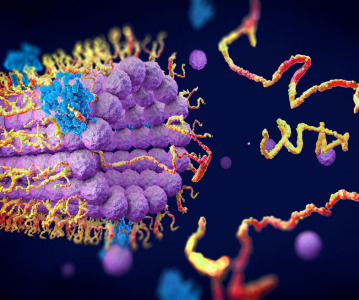NIH-led researchers develop software that could facilitate drug development

AptaTRACE is the first algorithm that uses the full scope of sequencing data from a large number of selection rounds to capture sequence and structure features of aptamers that bind to the target.
A team of researchers led by a National Institutes of Health investigator, Teresa Przytycka, has developed a new software tool called AptaTRACE that could be an important advance for drug developers and other scientists who want to identify molecules that bind with high precision to targets of interest.
“This research is an excellent example of how the benefits of ‘big data’ critically depend upon the existence of algorithms that are capable of transforming such data into information,” said Dr Przytycka, a senior investigator at the National Center for Biotechnology Information (NCBI), a division of the NIH’s National Library of Medicine.
Aptamers are short RNA or DNA molecules that are capable of binding with high affinity and specificity to diverse biological targets. Aptamers bind to their targets because of features of their sequence and structure that are complementary to the biochemical characteristics of the target’s surface. Possible targets of aptamers include small organic molecules, proteins or protein complexes, virus surfaces and entire cells. This broad range of targets makes aptamers candidates for a wide variety of applications, ranging from molecular biosensors to drug delivery systems to antibody replacement.
AptaTRACE is designed for use in conjunction with High-Throughput Systematic Evolution of Ligands by Exponential Enrichment (HT-SELEX), a laboratory technique for identifying aptamers. HT-SELEX allows analyses of millions of sequences to identify the candidates that undergo selection for binding to the target.
The AptaTRACE tool analyses this data to find the common features (or “motifs”) among the sequences that bind.
AptaTRACE is the first algorithm that uses the full scope of sequencing data from a large number of selection rounds to capture sequence and structure features of aptamers that bind to the target. Such information allows researchers to better understand why some molecules bind and others do not. Understanding these binding motifs is critical for taking advantage of the aptamers identified via the HT-SELEX process to enable modifications that transform aptamers into drug delivery systems targeting specific cells, for example. Research describing AptaTRACE is published in the July 27 issue of Cell Systems.
AptaTRACE is the result of a collaboration between Dr Przytycka’s group and researchers from the Beckman Research Institute of City of Hope, Duarte, California, led by Dr. John Burnett, and from Freiburg University, Breisgau, Germany, led by Dr Rolf Backofen. The tool can be downloaded from NCBI at www.ncbi.nlm.nih.gov/CBBresearch/Przytycka/index.cgi#aptatools, as well as Cell Systems.
Related News
-
News A Day in the Life of a Start-Up Founder and CEO
At CPHI we work to support Start-Up companies in the pharmaceutical industry and recognise the expertise and innovative angles they bring to the field. Through our Start-Up Programme we have gotten to know some of these leaders, and in this Day in the ... -
News Biopharmaceutical manufacturing boost part of new UK government budget
In their national budget announced by the UK Labour Party, biopharmaceutical production and manufacturing are set to receive a significant boost in capital grants through the Life Sciences Innovative Manufacturing Fund (LSIMF). -
News CPHI Podcast Series: The power of proteins in antibody drug development
In the latest episode of the CPHI Podcast Series, Lucy Chard is joined by Thomas Cornell from Abzena to discuss protein engineering for drug design and development. -
News Amgen sues Samsung biologics unit over biosimilar for bone disease
Samsung Bioepis, the biologics unit of Samsung, has been issued a lawsuit brought forth by Amgen over proposed biosimilars of Amgen’s bone drugs Prolia and Xgeva. -
News CPHI Podcast Series: Why we need to consider women in clinical trials
The latest episode of the CPHI Podcast Series with Lucy Chard covers women's health, specifically women's representation in clinical trials, the associated bias, and the impacts on health for this population. -
News US FDA does not approve MDMA therapy for PTSD, requests more data
The MDMA-based therapeutic developed by Lykos Therapeutics, a California-based Public Benefit Corporation (PBC), has been reviewed and unapproved by the US FDA. The regulator has requested additional phase III trial data for further safety and efficacy... -
News Novartis and Viatris latest facing lawsuit over HeLa cell misuse
Global pharmaceutical companies Novartis and Viatris are the latest hit with a lawsuit claim pertaining to alleged misuse of the ‘HeLa’ cell line from the estate of woman whose cancerous tissue cells were taken without consent. -
News Sanofi invests billions into Frankfurt insulin production site
French pharmaceutical company Sanofi have announced an investment of EUR1.3 billion at their existing BioCampus site in Frankfurt am Main for the expansion of insulin production.
Position your company at the heart of the global Pharma industry with a CPHI Online membership
-
Your products and solutions visible to thousands of visitors within the largest Pharma marketplace
-
Generate high-quality, engaged leads for your business, all year round
-
Promote your business as the industry’s thought-leader by hosting your reports, brochures and videos within your profile
-
Your company’s profile boosted at all participating CPHI events
-
An easy-to-use platform with a detailed dashboard showing your leads and performance



.png)

.png)
.png)
.png)